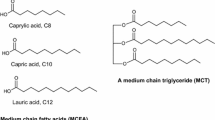Abstract
The objective was to determine whether rats could synthesize longer chain polyunsaturates from hexadecadienoate (16∶2n−6) and hexadecatrienoate (16∶3n−3). Rats were gavaged with uniformly13C-labelled hexadecadienoate or hexadecatrienoate, euthanized 24 h later, and total lipids were extracted from liver and carcass. Gas chromatogrpahy/combustion/isotope ratio mass spectrometry was used to measure13C levels in individual liver, carcass, and whole body fatty acids.13C Enrichment was present in desaturated and chain-elongated polyunsaturates, including linoleate, arachidonate, α-linolenate, and docosahexaenoate at 12–13% of the dose of tracer given.13C Enrichment from hexadecatrienoate was highest in carcass and liver α-linolenate, representing 3.5 and 17.9% of the total α-linolenate pool, respectively. For linoleate, arachidonate, or docosahexaenoate, the contribution of13C did not exceed 0.2% of the total body pool. Green leafy vegetables common in the human diet were shown to contain up to 1.2% of total fatty acids as hexadecadienoate and 11.6% as hexadecatrienoate. Hence, humans consuming green vegetables probably synthesize a small proportion of their total body content of linoleate and α-linolenate.
Similar content being viewed by others
Abbreviations
- GC/C/IRMS:
-
gas chromatography/combustion/isotope ratio mass spectrometry
- PUFA:
-
polyunsaturate fatty acids
References
Sprecher, H. (1968) The Total Synthesis and Metabolism of 4-Decaenoate, Dodeca-3,6-Dienoate, Tetradeca-5,8-Dienoate and Hexadeca-7,10-Dienoate in the Fat-Deficient Rat,Lipids 3, 14–20.
Klenk, E. (1965) The Metabolism of Polyenoic Fatty Acids,Adv. Lipid Res. 3, 1–23.
Cunnane, S.C., Williams, S.C.R., Bell, J.D., Brookes, S., Craig, K., Iles, R.A., and Crawford, M.A. (1994) Utilization of [U-13C]-Polyunsaturated Fatty Acids in the Synthesis of Long Chain Fatty Acids and Cholesterol Accumulating in the Neonatal Rat Brain,J. Neurochem. 62, 2429–2436.
Simopoulos, A.P., Norman, H.A., Gillaspy, J.E., and Duke, J.A. (1992) Common Purslane: A Source of Omega-3 Fatty Acids and Antioxidants,J. Am. Coll. Nutr. 11, 374–382.
Author information
Authors and Affiliations
About this article
Cite this article
Cunnane, S.C., Ryan, M.A., Craig, K.S. et al. Synthesis of linoleate and α-linolenate by chain elongation in the rat. Lipids 30, 781–783 (1995). https://doi.org/10.1007/BF02537807
Received:
Revised:
Accepted:
Issue Date:
DOI: https://doi.org/10.1007/BF02537807




